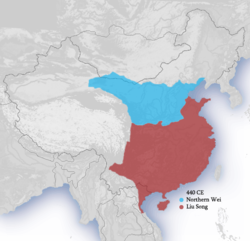
Back Suidelike en Noordelike Dinastieë Afrikaans السلالات الحاكمة الجنوبية والشمالية Arabic Dinastíes Meridionales y Septentrionales AST Cənub və Şimal sülalələri Azerbaijani Паўднёвыя і Паўночныя дынастыі Byelorussian Южни и северни династии Bulgarian Tierniezhioù ar su hag an norzh Breton Dinasties Meridionals i Septentrionals Catalan Nàng-báe̤k-dièu CDO Jižní a severní dynastie Czech
This article has multiple issues. Please help improve it or discuss these issues on the talk page. (Learn how and when to remove these template messages)
|
| Northern dynasties | Southern dynasties | ||
|---|---|---|---|
| Northern Wei 386–535 | Liu Song 420–479 | ||
| Southern Qi 479–502 | |||
| Liang 502–557 | |||
| Western Wei 535–557 |
Eastern Wei 534–550 | ||
| Northern Zhou 557–581 |
Northern Qi 550–577 |
Chen 557–589 |
Western Liang 555–587 |
| Northern and Southern dynasties | |||||||||||||||||||||||||||
|---|---|---|---|---|---|---|---|---|---|---|---|---|---|---|---|---|---|---|---|---|---|---|---|---|---|---|---|
 Approximate territories of the Northern Wei dynasty (blue) and Liu Song dynasty (red) in 440 | |||||||||||||||||||||||||||
 Approximate territories of the Northern Qi dynasty (dark blue), Northern Zhou dynasty (light blue), Chen dynasty (red), and Western Liang dynasty (pink) in 560 | |||||||||||||||||||||||||||
| Chinese | 南北朝 | ||||||||||||||||||||||||||
| |||||||||||||||||||||||||||
| Part of a series on the |
| History of China |
|---|
The Northern and Southern dynasties (Chinese: 南北朝; pinyin: Nán běi cháo) was a period of political division in the history of China that lasted from 420 to 589, following the tumultuous era of the Sixteen Kingdoms and the Eastern Jin dynasty. It is sometimes considered as the latter part of a longer period known as the Six Dynasties (220–589).[1] Albeit an age of civil war and political chaos, it was also a time of flourishing arts and culture, advancement in technology, and the spread of Mahayana Buddhism and Daoism. The period saw large-scale migration of the Han people to the lands south of the Yangtze. The period came to an end with the unification of all of China proper by Emperor Wen of the Sui dynasty.
During this period, the process of sinicization accelerated among the non-Han ethnicities in the north and among the indigenous peoples in the south. This process was also accompanied by the increasing popularity of Buddhism (introduced into China in the 1st century) in both northern and southern China and Daoism gaining influence as well, with two essential Daoist canons written during this period.
Notable technological advances occurred during this period. The invention of the stirrup during the earlier Jin dynasty (266–420) helped spur the development of heavy cavalry as a combat standard. Historians also note advances in medicine, astronomy, mathematics, and cartography. Intellectuals of the period include the mathematician and astronomer Zu Chongzhi (429–500), and astronomer Tao Hongjing.
- ^ Gascoigne, Bamber (2003). The dynasties of China : a history (1st Carroll & Graf ed.). New York: Carroll & Graf Publishers. ISBN 978-0786712199.